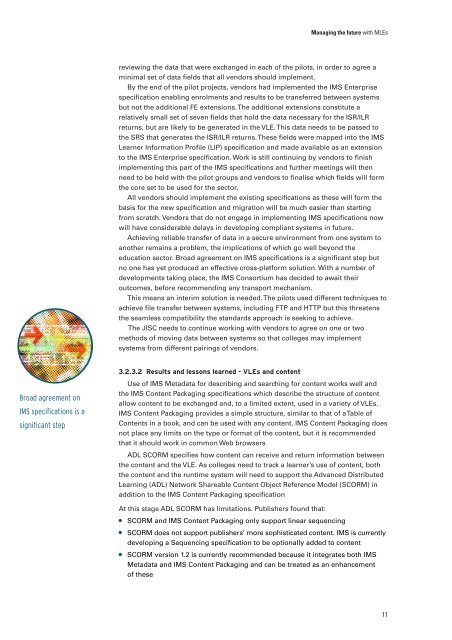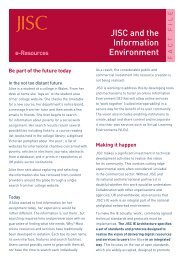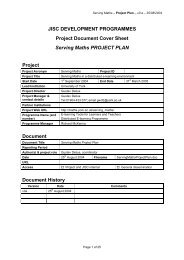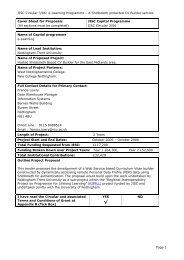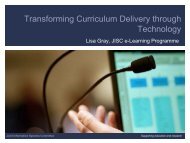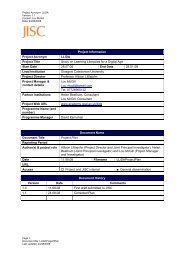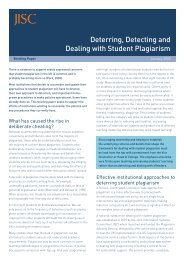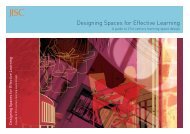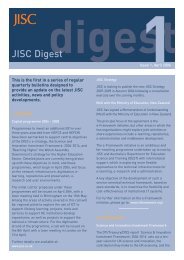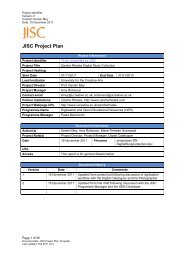Managing the future with MLEs - Jisc
Managing the future with MLEs - Jisc
Managing the future with MLEs - Jisc
Create successful ePaper yourself
Turn your PDF publications into a flip-book with our unique Google optimized e-Paper software.
<strong>Managing</strong> <strong>the</strong> <strong>future</strong> <strong>with</strong> <strong>MLEs</strong><br />
reviewing <strong>the</strong> data that were exchanged in each of <strong>the</strong> pilots, in order to agree a<br />
minimal set of data fields that all vendors should implement.<br />
By <strong>the</strong> end of <strong>the</strong> pilot projects, vendors had implemented <strong>the</strong> IMS Enterprise<br />
specification enabling enrolments and results to be transferred between systems<br />
but not <strong>the</strong> additional FE extensions. The additional extensions constitute a<br />
relatively small set of seven fields that hold <strong>the</strong> data necessary for <strong>the</strong> ISR/ILR<br />
returns, but are likely to be generated in <strong>the</strong> VLE. This data needs to be passed to<br />
<strong>the</strong> SRS that generates <strong>the</strong> ISR/ILR returns. These fields were mapped into <strong>the</strong> IMS<br />
Learner Information Profile (LIP) specification and made available as an extension<br />
to <strong>the</strong> IMS Enterprise specification. Work is still continuing by vendors to finish<br />
implementing this part of <strong>the</strong> IMS specifications and fur<strong>the</strong>r meetings will <strong>the</strong>n<br />
need to be held <strong>with</strong> <strong>the</strong> pilot groups and vendors to finalise which fields will form<br />
<strong>the</strong> core set to be used for <strong>the</strong> sector.<br />
All vendors should implement <strong>the</strong> existing specifications as <strong>the</strong>se will form <strong>the</strong><br />
basis for <strong>the</strong> new specification and migration will be much easier than starting<br />
from scratch. Vendors that do not engage in implementing IMS specifications now<br />
will have considerable delays in developing compliant systems in <strong>future</strong>.<br />
Achieving reliable transfer of data in a secure environment from one system to<br />
ano<strong>the</strong>r remains a problem, <strong>the</strong> implications of which go well beyond <strong>the</strong><br />
education sector. Broad agreement on IMS specifications is a significant step but<br />
no one has yet produced an effective cross-platform solution. With a number of<br />
developments taking place, <strong>the</strong> IMS Consortium has decided to await <strong>the</strong>ir<br />
outcomes, before recommending any transport mechanism.<br />
This means an interim solution is needed. The pilots used different techniques to<br />
achieve file transfer between systems, including FTP and HTTP but this threatens<br />
<strong>the</strong> seamless compatibility <strong>the</strong> standards approach is seeking to achieve.<br />
The JISC needs to continue working <strong>with</strong> vendors to agree on one or two<br />
methods of moving data between systems so that colleges may implement<br />
systems from different pairings of vendors.<br />
3.2.3.2 Results and lessons learned - VLEs and content<br />
Broad agreement on<br />
IMS specifications is a<br />
significant step<br />
Use of IMS Metadata for describing and searching for content works well and<br />
<strong>the</strong> IMS Content Packaging specifications which describe <strong>the</strong> structure of content<br />
allow content to be exchanged and, to a limited extent, used in a variety of VLEs.<br />
IMS Content Packaging provides a simple structure, similar to that of a Table of<br />
Contents in a book, and can be used <strong>with</strong> any content. IMS Content Packaging does<br />
not place any limits on <strong>the</strong> type or format of <strong>the</strong> content, but it is recommended<br />
that it should work in common Web browsers<br />
ADL SCORM specifies how content can receive and return information between<br />
<strong>the</strong> content and <strong>the</strong> VLE. As colleges need to track a learner’s use of content, both<br />
<strong>the</strong> content and <strong>the</strong> runtime system will need to support <strong>the</strong> Advanced Distributed<br />
Learning (ADL) Network Shareable Content Object Reference Model (SCORM) in<br />
addition to <strong>the</strong> IMS Content Packaging specification<br />
At this stage ADL SCORM has limitations. Publishers found that:<br />
• SCORM and IMS Content Packaging only support linear sequencing<br />
• SCORM does not support publishers’ more sophisticated content. IMS is currently<br />
developing a Sequencing specification to be optionally added to content<br />
• SCORM version 1.2 is currently recommended because it integrates both IMS<br />
Metadata and IMS Content Packaging and can be treated as an enhancement<br />
of <strong>the</strong>se<br />
11


